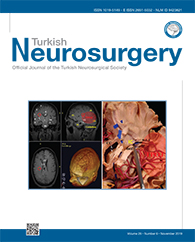Turkish Neurosurgery
2019 , Vol 29 , Num 6
Intentional Herniation Technique with the Neuroform EZ Stent System for Preservation of Aneurysmal Neck Branch: A Case Report
1Shinko Memorial Hospital, Department of Neurosurgery, Kobe, Japan
DOI :
10.5137/1019-5149.JTN.21334-17.2
Endovascular treatment of bifurcation aneurysms is difficult and complicated because arterial branches may arise from the
aneurysmal neck. We treat these cases with complex techniques such as Y or T stenting. In this report, we deployed one Neuroform
EZ stent using the intentional herniation technique for the preservation of arterial branches. A 78-year-old female presented with
two unruptured aneurysms. One was an 8 mm aneurysm located at the bifurcation of the internal carotid artery and the posterior
communicating artery (PcomA). The other was an 11 mm aneurysm located at the cavernous segment of the internal carotid artery.
A 4.5Ã20 mm Neuroform EZ stent was placed across the aneurysm neck. The delivery wire and microcatheter were pushed during
deployment, similar to braided stents. High resolution cone beam computed tomography (CT) after stenting revealed the stent strut
to be vertically aligned near the aneurysmal sac, and the PcomA orifice was preserved. We performed coil embolization easily and
achieved acceptable obliteration. Our intentional herniation technique may be useful in some cases. Open cell stents have some
advantages depending on the method of deployment.
Keywords :
Neuroform EZ stent, High resolution cone beam CT, Stent assisted coil embolization





